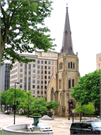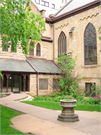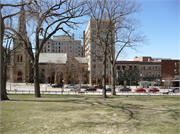Property Record
6 N CARROLL ST (A.K.A. 100 W WASHINGTON AVE)
Architecture and History Inventory
| Historic Name: | Grace Episcopal Church |
|---|---|
| Other Name: | Grace Episcopal Church |
| Contributing: | |
| Reference Number: | 16080 |
| Location (Address): | 6 N CARROLL ST (A.K.A. 100 W WASHINGTON AVE) |
|---|---|
| County: | Dane |
| City: | Madison |
| Township/Village: | |
| Unincorporated Community: | |
| Town: | |
| Range: | |
| Direction: | |
| Section: | |
| Quarter Section: | |
| Quarter/Quarter Section: |
| Year Built: | 1855 |
|---|---|
| Additions: | 1858 1870 1868 1885 |
| Survey Date: | 1973 |
| Historic Use: | house of worship |
| Architectural Style: | Early Gothic Revival |
| Structural System: | |
| Wall Material: | Sandstone |
| Architect: | James Douglas; David R. Jones-1885 interior |
| Other Buildings On Site: | |
| Demolished?: | No |
| Demolished Date: |
| National/State Register Listing Name: | Grace Episcopal Church |
|---|---|
| National Register Listing Date: | 1/1/1976 |
| State Register Listing Date: | 1/1/1989 |
| National Register Multiple Property Name: |
| Additional Information: | A 'site file' exists for this property. It contains additional information such as correspondence, newspaper clippings, or historical information. It is a public record and may be viewed in person at the Wisconsin Historical Society, State Historic Preservation Office. Map code is 0709-231-0901-5. This Gothic Revival church dates back to 1855-58 and was designed by James Douglas. It is one of the oldest churches in Madison. The sandstone construction of the church was supervised by James Livesay who had many stonemasonry contracts in the middle years of the nineteenth century [A]. Madison Landmark: 5/24/1976. Guild hall was built in 1894-1895. Designed by an architect from Milwaukee, this graceful yellow limestone building was inspired by early English Gothic models, appropriate for the American branch of the Church of England. The buttressed Gothic bell tower soars skyward, culminating in a polygonal spire pierced by gabled dormers. Lancet-arched windows and doors, along with finials (originally taller and more elaborate) at the base of the spire, enhance the sense of upward movement. Douglas articulated each successive level of the three-stage steeple by grouping together the corresponding number of windows. In 1885, local architect David R. Jones, collaborating with a Chicago firm, redesigned the interior. Douglas’s original design had featured a high, vaulted ceiling and Gothic arches outlined in wood, but it proved difficult to heat. The new lowered ceiling stayed true to the original Gothic Revival theme by placing a traditional hammer-beam ceiling below the old vaulting and embellishing it with quatrefoils and a large pointed arch. In the 1920s, the congregation added a second bay to the church and built a chapel along Carroll Street in a harmonious design. Stained-glass windows were first added in 1887, including an English-made Resurrection Window. The Baptistery Window of 1899 was made by Louis Comfort Tiffany's celebrated New York firm. |
|---|---|
| Bibliographic References: | [A]. "Sandstone and Buffalo Robes." Wisconsin State Journal 3/16/1894. Wisconsin State Journal 1/2/1895. Buildings of Wisconsin manuscript. Madison's Pioneer Buildings: A Downtown Walking Tour, 1987. A Celebration of Architecture: Wisconsin Society of Architects Tour of Significant Architecture, 1979. |
| Wisconsin Architecture and History Inventory, State Historic Preservation Office, Wisconsin Historical Society, Madison, Wisconsin |





